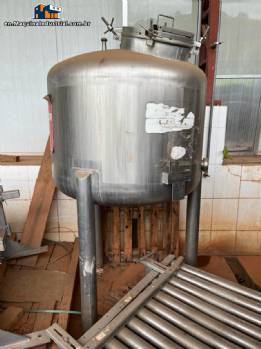Deaerator Tank (Deaeration):
What is it for:
A deaerator tank, also known as a deaerator, is used in industrial systems to remove dissolved gases, primarily oxygen, from liquid fluids such as water or other process liquids. The presence of excessive oxygen can be harmful in industrial systems, especially in boiler water systems and cooling systems, where corrosion and deposit formation can occur. The purpose of the deaerator is to reduce the concentration of dissolved gases to improve operational efficiency and extend the useful life of equipment.
How it works:
The basic operation of a deaerator tank involves the following steps:
Liquid Inlet: The liquid to be deaerated, generally water, enters the deaerator tank.
Vacuum Deaeration: The tank is kept under vacuum, removing air and other dissolved gases. The vacuum is created using vacuum pumps or other deaerating devices.
Heating (Optional): In some cases, the liquid can be heated to increase the efficiency of the deaeration process, as dissolved gases have lower solubility in heated liquids.
Gas Removal: The vacuum created in the tank allows dissolved gases, especially oxygen, to be released from the liquid. This occurs because the reduced pressure facilitates the evaporation of gases.
Thermal Conditioning and Return: The deaerated liquid is then thermally conditioned, if necessary, and returned to the industrial process.
Characteristics of Deaerator Tanks:
Construction Materials: Deaerator tanks can be constructed from corrosion-resistant materials, such as stainless steel, to ensure the integrity and durability of the equipment.
Vacuum Pump: They are often equipped with vacuum pumps to create the vacuum environment necessary for efficient removal of dissolved gases.
Temperature Control: Some deaerator tanks may include temperature control systems to optimize the deaeration process.
Monitoring Systems: They can be equipped with monitoring systems to measure the concentration of gases dissolved in the liquid.
Gas Out: Gases removed during the deaeration process are generally directed out of the system to avoid reintroduction into the deaerated liquid.
Benefits of Using Deaerator Tanks:
Corrosion Prevention: Removing oxygen reduces the risk of corrosion in boiler water systems and other metal components.
Thermal Efficiency: Deaeration can improve thermal efficiency in boiler systems since the presence of dissolved gases can reduce heat transfer.
Equipment Protection: Extends the useful life of components and equipment, minimizing the adverse effects of corrosion and deposits.
Improved Product Quality: In sensitive industrial applications, deaeration can contribute to the production of better quality products.
Maintenance Reduction: Effective removal of dissolved gases can reduce the need for corrective and preventive maintenance in industrial systems.
Operational Safety: Contributes to the safe and reliable operation of systems involving liquid fluids.
Deaerator tanks are important components in many industrial processes, especially where the presence of dissolved gases can have adverse impacts on the efficiency and integrity of the systems.
In the beverage industry, a deaeration tank is used to remove dissolved gases, mainly oxygen, from liquid, such as water or solutions used in beverage production. Here are some of the main functions and benefits of a deaeration tank in the beverage industry:
Oxidation Prevention: The presence of oxygen can lead to the oxidation of compounds present in beverages, resulting in unwanted changes in flavor, color and aroma. The deaeration tank helps reduce oxygen concentration, preventing oxidation.
Improved Chemical Stability: By removing dissolved gases, especially oxygen, the deaeration tank contributes to the chemical stability of liquid ingredients in beverages. This is essential to maintain the quality and integrity of the components.
Preservation of Flavor and Aroma: Dissolved gases, such as oxygen, can interact with compounds present in beverages, negatively impacting flavor and aroma. Deaeration preserves sensorial quality, avoiding unwanted flavors.
Prevention of Microbiological Contamination: Reducing oxygen in the liquid also creates an environment less conducive to the growth of aerobic microorganisms, contributing to the prevention of microbiological contamination in beverages.
Increased Shelf Life: Effective oxygen removal can extend the shelf life of beverages, preventing degradation processes and maintaining quality over time.
Control in the Production of Carbonated Drinks: In carbonated drinks, the presence of oxygen can affect the carbonation and quality of the drinks. Deaeration is crucial to ensure the integrity of the effervescent characteristics.
Quality Maintenance during Filling: During the filling process, deaeration can be applied to ensure that the filled liquid is free of oxygen, contributing to the maintenance of quality during storage and transport.
Reducing Water Treatment Costs: Oxygen dissolved in water can interfere with treatment processes, such as reverse osmosis. Prior deaeration of water can reduce costs associated with treatment.
In summary, the deaeration tank plays a fundamental role in guaranteeing the quality and stability of beverages, contributing to the preservation of the desired sensorial characteristics and preventing problems related to oxidation and contamination. |




